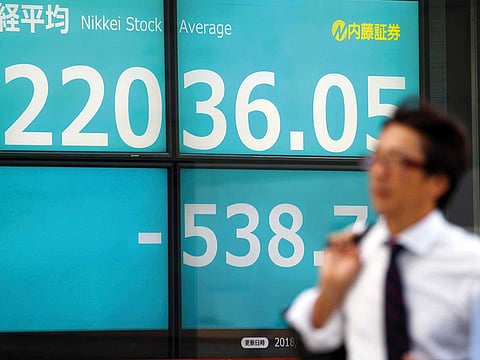Yen breaks 150 level as intervention speculation ramps up
Yen reversed losses to trade little changed at 149.87/dollar as of 10:15 am in London

Tokyo: The yen weakened past the closely-watched 150 per dollar level boosting up speculation that more intervention will be needed to support the Japanese currency.
It slipped as much as 0.2 per cent to 150.08 per dollar Thursday after a surge in Treasury yields to multi-year highs widened the gap with Japanese equivalents. That marked a new 32-year low for the yen, which has continued to slide despite the efforts of authorities to support it by intervening in the market in September.
The yen quickly reversed losses to trade little changed at 149.87 per dollar as of 10:15 am in London.
“It’s a tricky situation for Japanese authorities. The may want to avert conveying the message that there is a line in the sand at 150.00 or any other level, as this is a risky move in such a volatile environment, said Francesco Pesole, currency strategist at ING Bank. “But the risk is that they let it fly above 150 and there you get the upward volatility they were trying to avoid in the first place. I think they’ll have to intervene now.”
Finance Minister Shunichi Suzuki declined to comment on Thursday on whether authorities had intervened, but said that he would continue to watch the foreign exchange market as the country would not tolerate speculative moves in the currency.
“There is no change in our stance that we will take bold action against those kinds of moves,” Suzuki told reporters in Tokyo.
The comments echo those of other Japanese authorities who have said they will act if there are extreme moves in the currency rather than target any particular level.
The yen has wiped out last month’s intervention-driven gains despite the government confirming an almost $20 billion spend and unleashing a barrage of warnings to dissuade traders from testing its resolve. It has tumbled 23 per cent against the greenback this year as traders focused on the widening yield differential between the US and Japan, which favors dollar assets.
“Policymakers have painted themselves in a corner. FX intervention didn’t have as lasting impact as everyone thought,” said Stuart Bennett, head of G-10 FX strategy at Santander CIB. “Another bout of intervention looks very likely, that is what has happened in the past, but it’s difficult to see that working and whatever level it is made at will probably just become a target for the market.”
Still, options markets are suggesting the market is bracing for another bout of yen-buying intervention, with bets building for a turnaround in the Japanese currency in the near term.
Stealth intervention
The yen’s continued slide is also fueling speculation that authorities are subtly intervening as traders are observing sudden, short-lived bursts of strength when fresh lows beckon. So-called stealth intervention typically involves entering the market on a smaller scale that is more difficult to detect instead of the sharp sudden shifts associated with more regular intervention.
Stealth intervention “is a waste of time and not really addressing the underlying issue,” said Bipan Rai, head of foreign-exchange strategy at Canadian Imperial Bank of Commerce. “In order to really stabilize dollar-yen, the selloff in long end US rates needs to slow, or reverse. Failing that, the BOJ would have to amend its yield-curve control program”
Given the ongoing rise in US bond yields, many in the market expect that the dollar will continue its climb against the yen, and Alvin Tan, head of Asia FX strategy at RBC Capital Markets, believes that a push to 160 yen in the coming months was “not out of the question.”
While Treasury yields are free to rise, Japan’s 10-year benchmark is capped by the BOJ’s curve-control policy, which seeks to keep it at or under 0.25 per cent in a bid to boost the economy. The consequences of that policy was evident once more Thursday when the central bank announced unscheduled bond purchases as the 10-year yield briefly rose above that ceiling.
“The Bank of Japan has to chose between yield-curve-control or fighting JPY weakness,” said Kristoffer Kjaer Lomholt, head of FX research at Danske Bank in Copenhagen. “As of now, the revealed preference still indicates a preference for keep YCC control in place.”
Sign up for the Daily Briefing
Get the latest news and updates straight to your inbox



